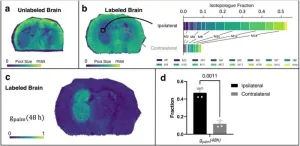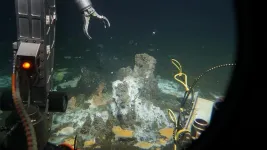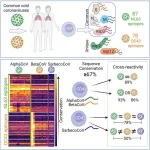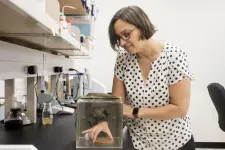(Press-News.org) Tumors are composed of rapidly multiplying cancer cells. Understanding which biochemical processes fuel their relentless growth can provide hints at therapeutic targets.
Researchers from Washington University in St. Louis have developed a technology to study tumor growth in another dimension — literally. The scientists established a new method to watch what nutrients are used at which rates spatially throughout a tissue.
By using this multidimensional imaging approach, they identified pathways whose activities are uniquely elevated in brain cancer, offering clues for potential treatment strategies. The study was published May 19 in Nature Communications.
“We figured out how to infer the rate of biochemical reactions directly from discrete regions of tissue,” said Gary Patti, the Michael and Tana Powell Professor of Chemistry in Arts & Sciences and a professor of medicine at the School of Medicine. Patti, who is also a research member of the Siteman Cancer Center at Barnes-Jewish Hospital and Washington University School of Medicine, is senior author of the new study.
Human biology is intrinsically 3D in nature. The emerging field of spatial biology aims to capture this geometry by imaging the locations of genes, proteins and metabolites. The approach reported by Patti and colleagues extends spatial profiling to fluxes, the rates at which molecules are transformed inside of cells.
"Other technologies provide what is essentially a roadmap of biochemistry. Our goal was to add in a measurement of how fast traffic is flowing on the different roads," Patti said.
By Patti’s analogy, the new method is akin to the feature in Google Maps that uses green and red colors to indicate the density of cars on a given street.
Using a mouse model of glioblastoma, a deadly form of brain cancer in humans, the researchers created a high-resolution map of the “tumor ecosystem.” This allowed them to tell which molecules were located in what parts of the brain and how quickly those molecules were turning into other things.
The results shed light on how cancer cells in a brain tumor get lipids, a basic component of fat.
Lipids are required to make the outermost covering of a cell, known as a membrane. As cancer cells multiply, they need lipids to encase the new cells. Previous work from Patti had shown that cancer cells prefer to scavenge lipids from their local environments. But that was when cancer cells were cultured in isolation with lipids present in the media.
The new study showed that cancer cells in the brain tend to make, rather than siphon off, the lipids that they need to multiply.
“The brain is a unique environment. The availability of lipids is more limited than in other tissues where tumors reside,” Patti explained.
The speed at which some lipids were synthesized was as much as 8-fold higher in brain tumors compared with surrounding healthy tissue. Although the exact magnitude of the increase varied, the pattern was surprisingly consistent in cancer cells throughout the tumor.
“A single tumor can span multiple different environments. The center might be hypoxic, while the outside is in contact with healthy tissue,” Patti said. “You might have predicted differences between these different regions, but we didn’t observe any patterns like that.”
This finding is important because knowing that cancer cells within brain tumors rely on the same biochemical pathway to fuel their growth means that scientists could target it to slow or stop disease progression.
“When a pathway is more active, its flux goes up. That makes it a good candidate for therapeutic intervention,” Patti said. “We are excited about testing whether impairment of fatty acid elongation will be effective in treating mouse models of disease.”
---
Schwaiger-Haber, M., Stancliffe, E., Anbukumar, D.S. et al. Using mass spectrometry imaging to map fluxes quantitatively in the tumor ecosystem. Nat Commun 14, 2876 (2023). https://doi.org/10.1038/s41467-023-38403-x
This study was funded in part by the McDonnell Center for Cellular and Molecular Neurobiology, as well as the National Institutes of Health grants R24 OD024624 and R35 ES2028365.
END
Cancer cells rev up synthesis, compared with neighbors
New spatial tools measure how fast nutrients are flowing through different pathways in a tumor
2023-06-01
ELSE PRESS RELEASES FROM THIS DATE:
Eye drops slow nearsightedness progression in kids, study finds
2023-06-01
COLUMBUS, Ohio – The results of a new clinical trial suggest that the first drug therapy to slow the progression of nearsightedness in kids could be on the horizon.
The three-year study found that a daily drop in each eye of a low dose of atropine, a drug used to dilate pupils, was better than a placebo at limiting eyeglass prescription changes and inhibiting elongation of the eye in nearsighted children aged 6 to 10.
That elongation leads to myopia, or nearsightedness, which starts in young kids and ...
New LUX search tool offers unprecedented access to Yale’s vast collections
2023-06-01
New Haven, Conn. — Yale University’s museums, libraries, and archives contain vast troves of cultural and scientific heritage that fire curiosity and fuel research worldwide. Now there’s a simple new way to make astonishing connections among millions of objects.
Starting today, anyone can explore the university’s unparalleled holdings online through LUX: Yale Collections Discovery — a groundbreaking discovery and research platform that provides single-point access to more than 17 million items, including defining specimens ...
Bremen researchers cultivate archaea that break down crude oil in novel ways
2023-06-01
Microbial communities are especially active near hydrothermal seeps like those in the Guaymas Basin in the Gulf of California. The team of researchers has been working on understanding these communities for many years. Organic material deposited in the Guaymas Basin is cooked by heat sources from within the Earth, which breaks it down into crude oil and natural gas. Their components provide the primary source of energy for microorganisms in an otherwise hostile environment. In their latest study, the researchers have demonstrated that archaea use a previously unknown mechanism to degrade liquid petroleum ...
Owkin powers a new era in oncology research with MOSAIC – an unprecedented $50 million spatial atlas of cancer cells
2023-06-01
– Cutting-edge spatial omics technologies to map cancer cells and their immune environment in high resolution, allowing AI to unlock potential for new breakthrough treatments –
– Landmark research project is 100x larger than existing efforts –
– Data will be generated from thousands of patients across multiple cancers –
– University of Pittsburgh, Gustave Roussy, Lausanne University Hospital, Uniklinikum Erlangen/Friedrich-Alexander-Universität Erlangen-Nürnberg , Charité ...
Adolescents are aware of and invested in the potential impacts of abortion restrictions, study says
2023-06-01
CHAPEL HILL, N.C. – On July 1, North Carolina’s new abortion limits go into effect. As restrictions on abortions are being tightened across the United States, adolescents may encounter mounting obstacles that could prevent them from accessing abortion care.
Bianca A. Allison, MD MPH, an assistant professor in the Department of Pediatrics, sought to examine the awareness and knowledge that adolescents have about the legal landscape of abortion and how these changes might affect them and their communities.
The study, published in the Journal of Adolescent Health, found that many adolescents – across a diversity of ...
Family resemblance: How T cells could fight many coronaviruses at once
2023-06-01
LA JOLLA, CA—Scientists at La Jolla Institute for Immunology (LJI) are investigating how the immune system's T cells react to a wide variety of coronaviruses, ranging from SARS to common cold coronaviruses. Their goal is to guide the development of vaccines that could halt future pandemic by combatting many types of coronaviruses at once.
"While it was recognized that coronaviruses were potentially dangerous viruses, because of SARSCoV and MERS viruses causing very severe disease in humans, nobody knew that the next pandemic was going to be caused by SARS-CoV-2," says LJI Professor Alessandro Sette, Dr.Biol.Sci. ...
New UNC study quantifies disparity among minority communities exposed to traffic-related air pollution across the U.S.
2023-06-01
Traffic-related air pollution is a pervasive problem across the United States. Vehicle emissions are highest near major roadways with around 19% of the U.S. population living in the vicinity of a major roadway. In more densely populated states, like California, up to 40% live near a major roadway. Exposure to these pollutants, such as fine particulate matter (PM2.5 ) and nitrogen dioxide (NO2), a byproduct of burning fossil fuel, can lead to a host of health effects including premature death. Minority communities often live along these corridors and experience disproportionate exposures.
A ...
Study identifies boat strikes as a growing cause of manatee deaths in Belize
2023-06-01
The endangered Antillean manatee faces a growing threat from boat strikes in Belize, according to a new study that raises concerns about the survival of what had been considered a relatively healthy population.
Belize hosts a population of around 1,000 manatees. With the growth of tourism in recent decades, however, Belize has seen a substantial increase in boat traffic, making boat strikes an increasingly important cause of manatee deaths and injuries.
The new study, published June 1 in Endangered Species Research, used 25 years of data on manatee strandings (dead or injured ...
Biologists to create ‘toolbox’ for understanding complex genetic traits
2023-06-01
Driven by a lifelong curiosity about the natural world and the diversity of life, Elizabeth King, associate professor in the Division of Biological Sciences at the University of Missouri, found inspiration to spend her formative years studying science — and along the way she discovered her passion for biology. That foundation has led her to pursue an ongoing career working to develop a better understanding of genetic traits from a biological perspective.
Recently, the National Institutes of Health (NIH) awarded King a five-year, $1.9 million grant to expand her lab’s research ...
Salton Sea environment detrimental to respiratory health of local children
2023-06-01
RIVERSIDE, Calif. -- In the United States, low-income immigrant and minority children often live in environments that have highly polluted air. A study led by researchers at the University of California, Riverside, demonstrates this among the Latinx and Purépecha immigrant children and caregivers living along Inland Southern California’s Salton Sea, a highly saline drying lakebed surrounded by agricultural fields. The Purépecha community is an Indigenous group from the Mexican state of Michoacán.
“Children of Latinx ...
LAST 30 PRESS RELEASES:
Making lighter work of calculating fluid and heat flow
Normalizing blood sugar can halve heart attack risk
Lowering blood sugar cuts heart attack risk in people with prediabetes
Study links genetic variants to risk of blinding eye disease in premature infants
Non-opioid ‘pain sponge’ therapy halts cartilage degeneration and relieves chronic pain
AI can pick up cultural values by mimicking how kids learn
China’s ecological redlines offer fast track to 30 x 30 global conservation goal
Invisible indoor threats: emerging household contaminants and their growing risks to human health
Adding antibody treatment to chemo boosts outcomes for children with rare cancer
Germline pathogenic variants among women without a history of breast cancer
Tanning beds triple melanoma risk, potentially causing broad DNA damage
Unique bond identified as key to viral infection speed
Indoor tanning makes youthful skin much older on a genetic level
Mouse model sheds new light on the causes and potential solutions to human GI problems linked to muscular dystrophy
The Journal of Nuclear Medicine ahead-of-print tip sheet: December 12, 2025
Smarter tools for peering into the microscopic world
Applications open for funding to conduct research in the Kinsey Institute archives
Global measure underestimates the severity of food insecurity
Child survivors of critical illness are missing out on timely follow up care
Risk-based vs annual breast cancer screening / the WISDOM randomized clinical trial
University of Toronto launches Electric Vehicle Innovation Ontario to accelerate advanced EV technologies and build Canada’s innovation advantage
Early relapse predicts poor outcomes in aggressive blood cancer
American College of Lifestyle Medicine applauds two CMS models aligned with lifestyle medicine practice and reimbursement
Clinical trial finds cannabis use not a barrier to quitting nicotine vaping
Supplemental nutrition assistance program policies and food insecurity
Switching immune cells to “night mode” could limit damage after a heart attack, study suggests
URI-based Global RIghts Project report spotlights continued troubling trends in worldwide inhumane treatment
Neutrophils are less aggressive at night, explaining why nighttime heart attacks cause less damage than daytime events
Menopausal hormone therapy may not pose breast cancer risk for women with BRCA mutations
Mobile health tool may improve quality of life for adolescent and young adult breast cancer survivors
[Press-News.org] Cancer cells rev up synthesis, compared with neighborsNew spatial tools measure how fast nutrients are flowing through different pathways in a tumor








